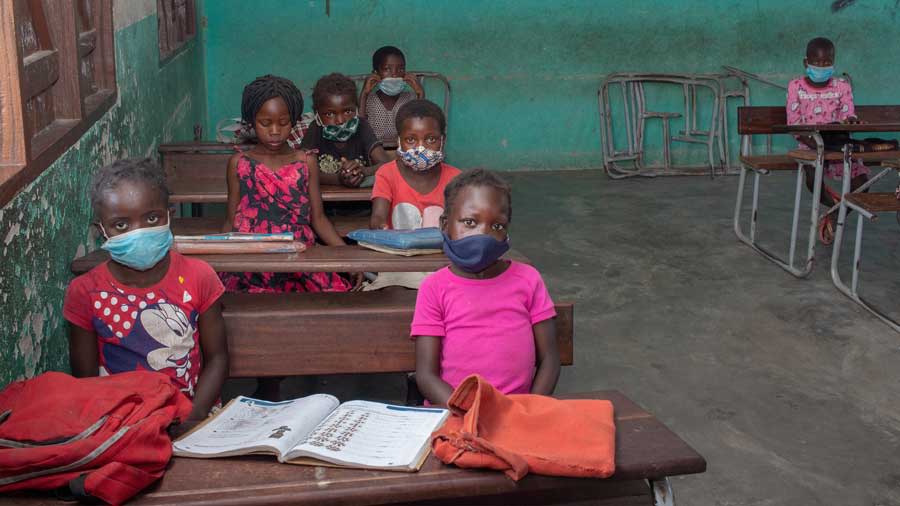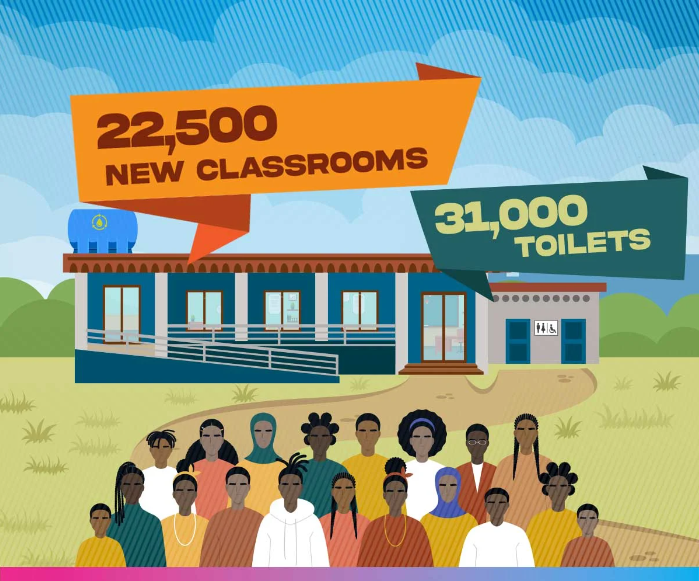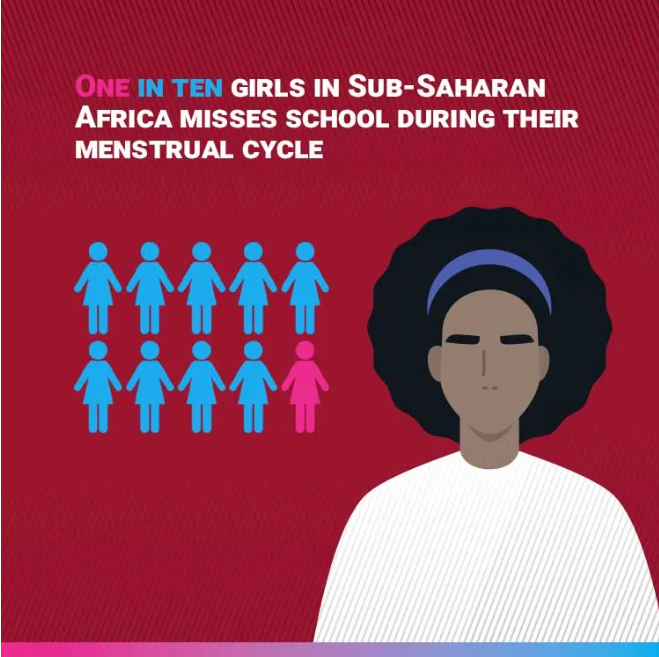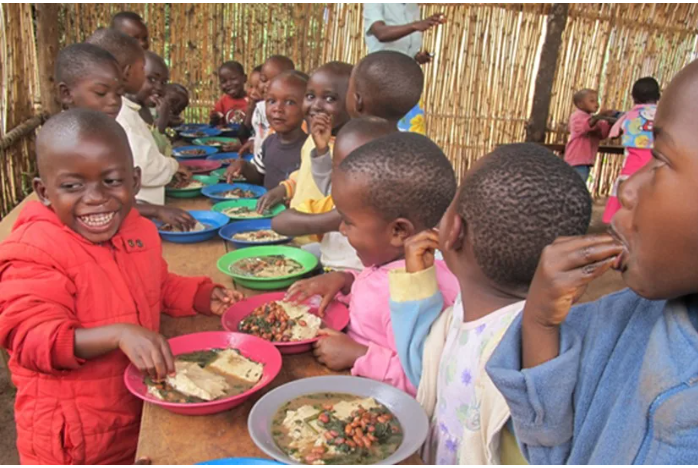Resource Type
Feature Story
Expand Systems, Equip with Skills, Empower All
This story was originally posted on worldbank.org/whoweare/news
Building forward-thinking systems to turn the tide on learning poverty

In Eastern and Southern Africa, about 89% of ten-year-old children are unable to read and understand a short text, reflecting a high percentage of learning poverty that was exacerbated during the pandemic. Globally, Sub-Saharan Africa continues to have the lowest participation rate in tertiary education despite enrollment doubling globally between 2000 and 2013 across all regions of the world. And in many parts of the region, especially the fragile and conflict-prone countries, societal barriers continue to persist, keeping many girls and boys out of school and preventing women especially from being educated and becoming equal members of society.![]()
Economies today require skills at varied levels and a robust education system in a country must be multi-pronged and equipped to impart knowledge and skills at all levels of the labor market. However, achieving optimal educational outcomes today is at best, challenging, as the world grapples with its worst education crisis in history following the COVID-19 pandemic.
With 323 million school-aged children (3-18 years) projected to live in Eastern and Southern Africa countries by 2023, these countries are not giving up—they have been doggedly implementing a series of bold reforms to their education systems across the board—from revamping curricula, teacher training, and classrooms to educating girls and women, to improve learning outcomes across the educational system and unleash their ability to lead.
The World Bank has been a steady partner working with countries to transform education systems and lay the foundation for a brighter future for the youngest of Africa’s citizens. Our strategy in the short and medium term aims to:
- EXPAND education systems with more infrastructure, teachers, and materials to succeed.
- EQUIP youth, entrepreneurs, and higher education systems with the skills and training needed to fuel economic growth.
- EMPOWER girls and children with disabilities to stay in school and enjoy more opportunities for learning and building skills.
Expand Education Systems: What Will it Take in Eastern and Southern Africa?
Expanding and improving the quality of education systems in the region has required concerted efforts by governments to (1) increase and rehabilitate the physical infrastructure of educational facilities, which provide the enabling conditions for greater equity in access and quality in instruction, and (2) implement critical reforms to improve the foundational systems upon which schools operate.

When it comes to rolling out safe, accessible, and climate-sensitive schools, Rwanda has led the charge, teaming up with the World Bank through five projects totaling more than $300 million to ensure quality education and a skilled labor force in the country. In the largest ever school expansion effort in the country, Rwanda has added more than 22,500 new classrooms that include accessibility features such as ramps for wheelchairs and gender-segregated toilets to allow students to access sanitation in a safe environment. With the significant expansion in classrooms, additional 68,000 Rwandan children ages 5-14 years old can now access school within a two-kilometer radius, cutting down their travel distance by a significant margin. All of this was accomplished in the span of two years.
“Students used to walk long distances and reached school very tired. They were required to wake up early and were dozing in class. This made it hard for the teacher to manage them, which delayed the lesson plans and completion of the curriculum. The new construction came to solve the problem. We believe that the quality of education has improved.”
Alotia Mukantwali, Head Teacher, Karama Primary School, Rwanda.
Thanks to the increase in classrooms, the primary student-to-classroom ratio dropped from 73 students to 49 students per class on a average, which has enabled better student-teacher interactions and quality of instruction. Looking to the future, Rwanda has consciously included rainwater harvesting systems and retaining walls in new school construction to address extreme rain and drought cycles and keep children comfortable and safe while in class.
Equally ambitious on expanding quality education for all, the Democratic Republic of Congo (DRC), supported by $800 million in International Development Association (IDA) financing, is driving major education reforms that include ensuring free primary school and improving the functioning and transparency of (1) teacher payment and recruitment systems and (2) the administration systems that manage schools at the provincial level.
Having access to free public education amidst conflict and political strife is especially refreshing for parents, who get to see their kids go to school every day and aspire for them to break out of the cycle of poverty and build successful lives for themselves.
“You can only get a good job if you have achieved a certain level of education. So I fight to ensure that my children can go to school. Now that school is free, I can pay my rent, feed my children, and save a bit.”
Esther Litamba, a mother in Kinshasa, DRC
The benefits of these reforms have been staggering: 2.3 million additional students enrolled in public primary schools in school year 2021-22; 58,000 new teachers brought on the payroll through a new merit-based recruitment program and paid regularly; and 20,000 safe and inclusive school focal points appointed in public primary schools as part of major efforts to reduce sexual exploitation and abuse/sexual harassment (SEA/SH). In April 2022, Allo Ecole was launched as a complaint resolution channel integrated into the education ministry's grievance mechanism to establish a dedicated reporting service to combat the tide of SEA/SH incidents.
Retaining students in school is critical to developing their potential, escaping the cycle of poverty, and contributing to shared prosperity

In Kenya, despite providing education services for over 16 million children and youth, at least 11% of girls drop out between grades 7 and 12. Kenya’s Primary Education Equity in Learning Project, financed by the World Bank, is creatively addressing barriers to these gender gaps.
School improvement plans now require inclusion of gender targets—from monitoring regular school attendance and deliberately tracking girls (and vulnerable boys) at risk of dropping out, to remedial actions to prevent dropouts. A package of scholarships, school kits, and mentoring support services specifically targeted toward girls and vulnerable boys will help address the economic and capacity constraints facing households, and boost the confidence and morale of these students.
A contributor to high dropout rates in upper primary schools is inadequate access to sanitary towels among the adolescent girls. A UNESCO report estimates that one in ten girls in Sub-Saharan Africa misses school during their menstrual cycle. By some estimates this equals as much as 20% of a given school year. No girl child should be constrained from receiving an education because of natural physiological occurrences. The project in Kenya is dedicated to strengthening the supply chain and accountability for government financed sanitary towels to help ensure uninterrupted school attendance by girls.
Zimbabwe has also made strides to retain adolescent girls in school. Through a pilot funded by the Zimbabwe Reconstruction Fund and implemented by CARE International, over one thousand girls in Buhera, one of the poorest and most water-scarce districts in Zimbabwe, were provided menstrual hygiene kits containing supplies for 12 months. The impact was lifechanging.
“Prior to receiving sanitary pads, we could easily miss school as we struggled to stand up during lessons in fear that we would have spoilt our uniforms. We no longer have to forego school to work where we would opt to receive payment as a bar of soap so that we could wash the fabrics we used during menstruation.”
Ruth Mbowo, Zvimoyo, secondary student and pilot beneficiary.
The pilot has also organized sensitization and awareness raising sessions for parents/caregivers and teachers at 48 project schools to encourage positive behavior change on menstrual hygiene management and supporting the girl child. Further assistance was provided via cash transfers and livelihood grants to help the girls’ families meet the other costs of their schooling.
Burundi is leveraging food as a safety net to keep kids in schools. Across seven of the poorest provinces in Burundi, many ravaged by drought and famine, two World Bank programs are serving a wholesome, hot meal to children while in school to boost nutrition as well as student retention. Most recently, the programs saw a 15% reduction in school dropouts in the provinces of Kirundo and Muyinga combined, areas with some of the lowest educational achievement numbers in the nation. 812 schools across the country have benefitted from the World Bank funded PAADESCO project.
“I am an orphan and come from the often-marginalized community of the Batwa. With the support of the school feeding program and the provision of school kits, I was able to return to school and I have continued my studies regularly and successfully.”
Mukarugamba Médine, beneficiary from Burundi

Equipping Students and Teachers: Real-World Skills for Productive Employment
Empower All: Every learner matters, and matters equally
Investing in Education for a Brighter Future
